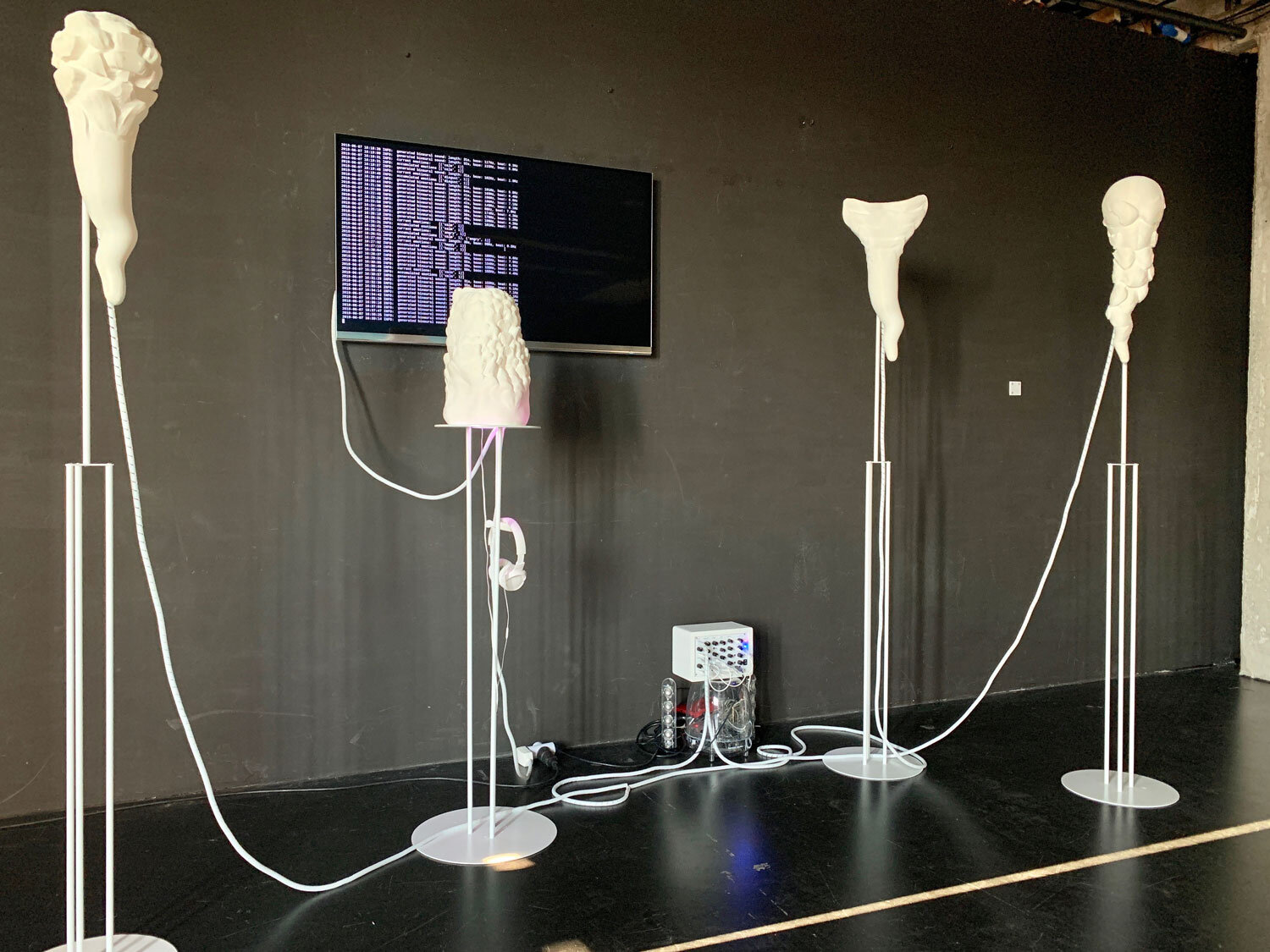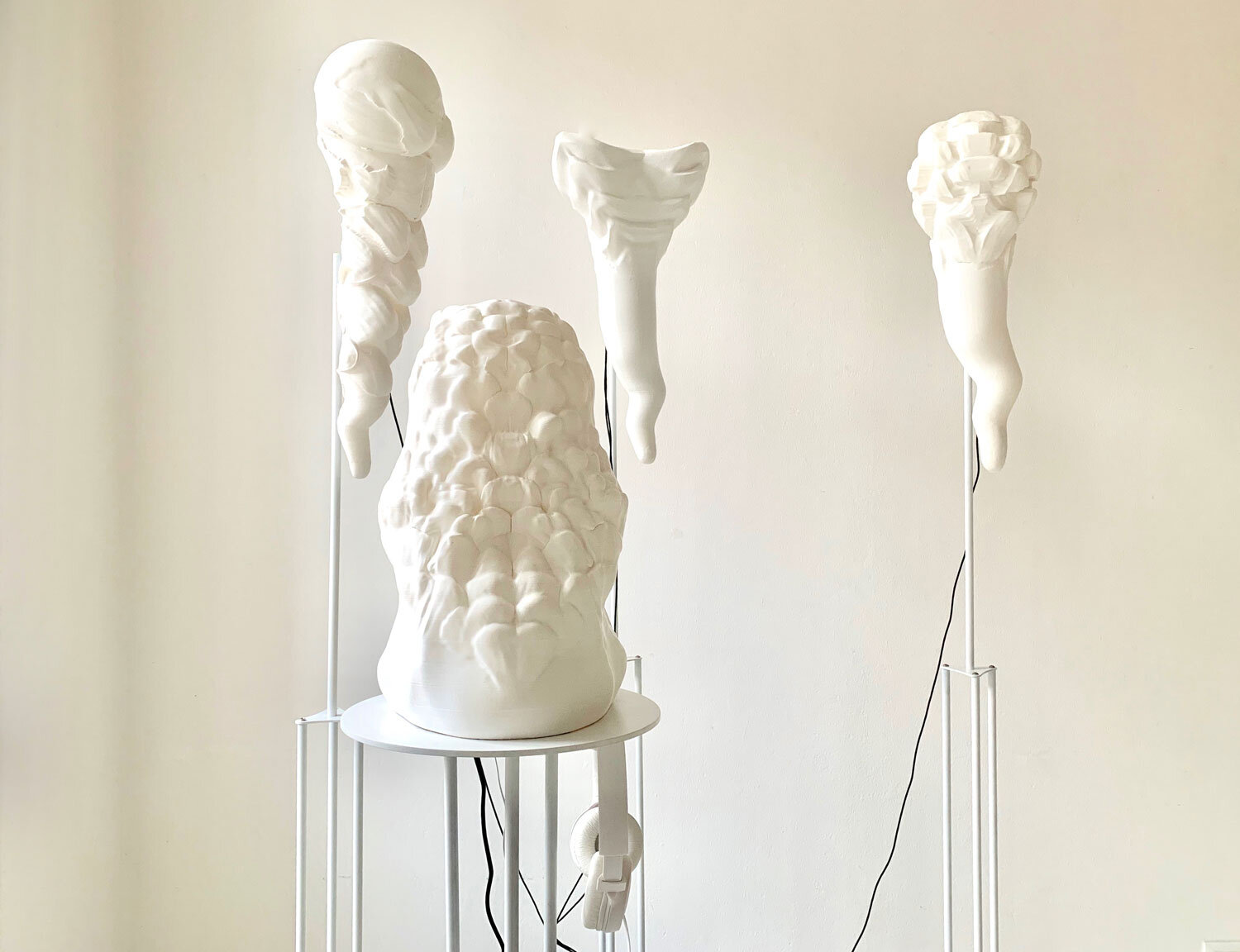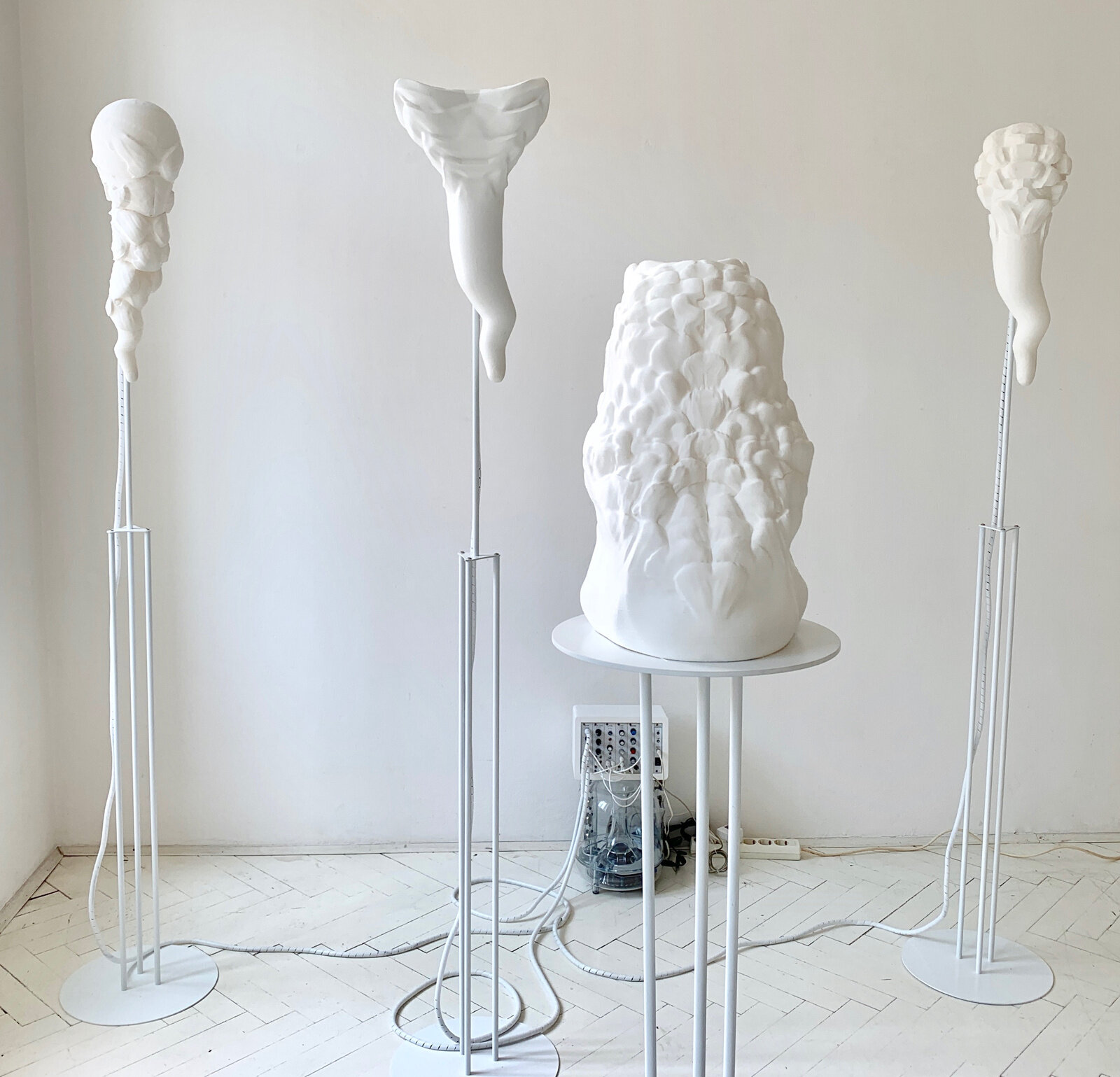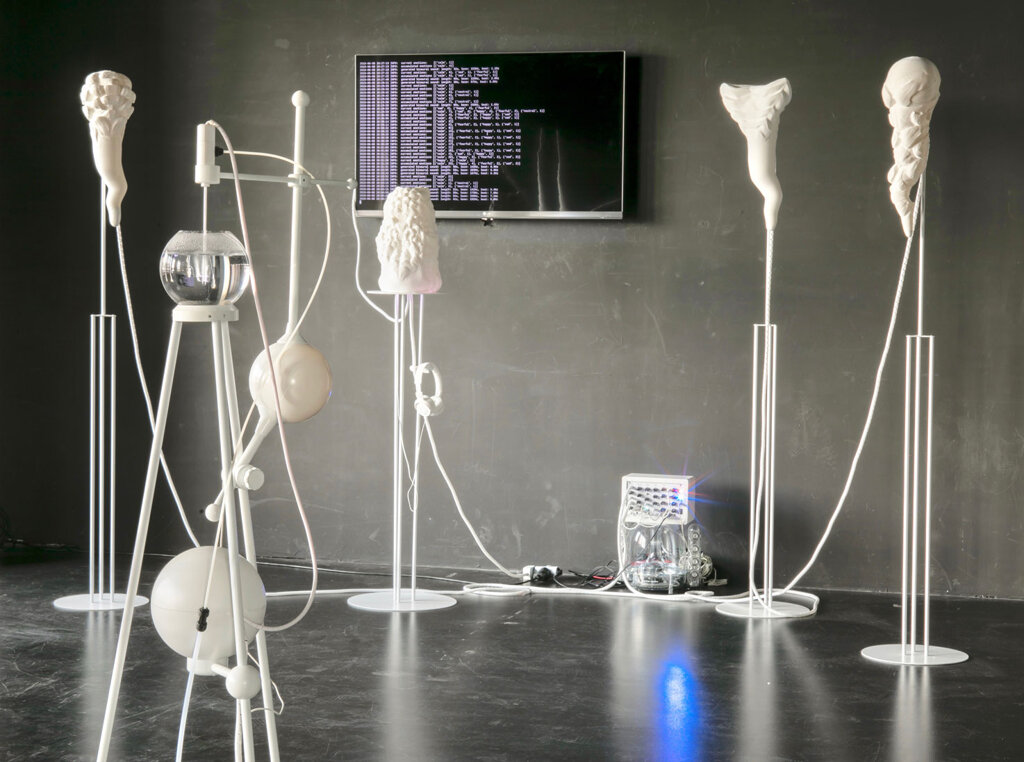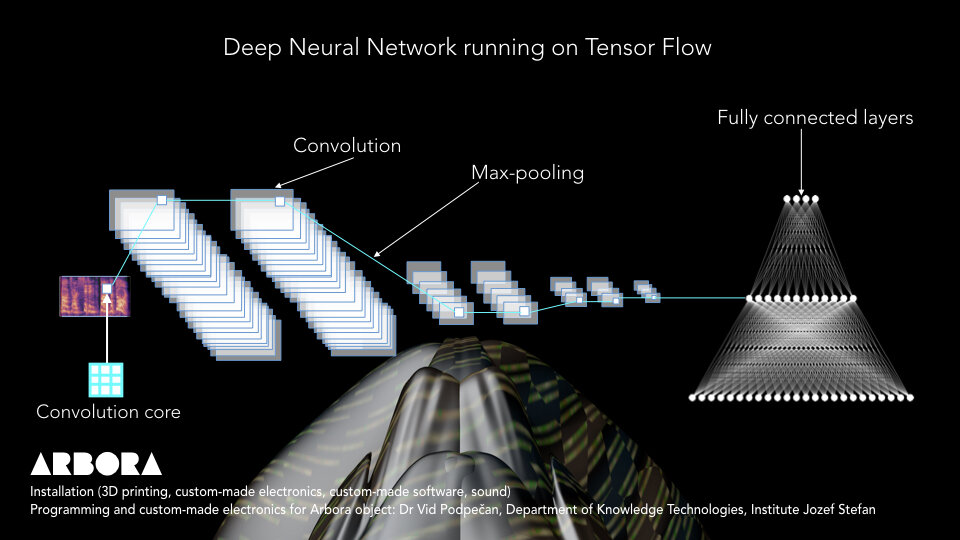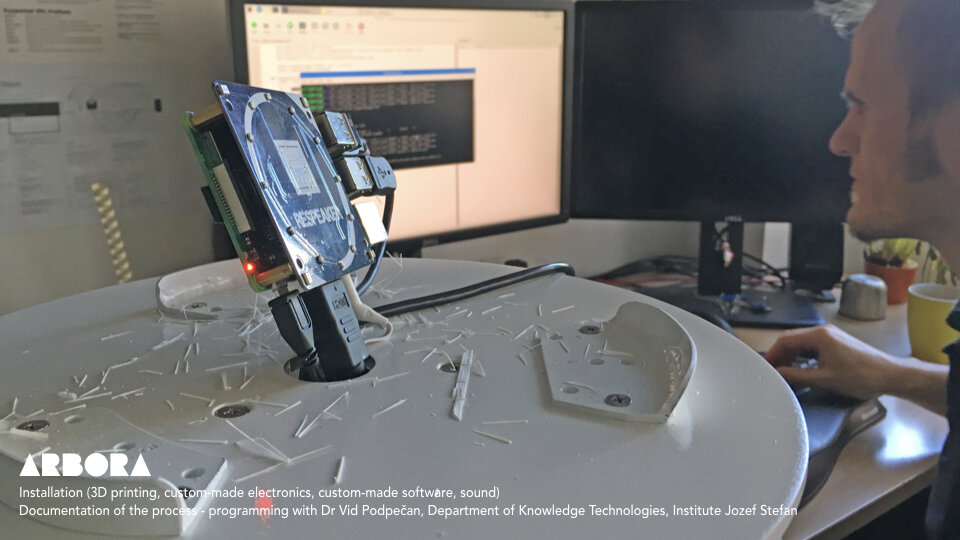Arbora
Arbora (Sphere2)
Media Art Installation, 2019.
3D printing, custom-made electronics, custom-made software, sound
3D modelling: Tanja Vujinovic
Programming and custom-made electronics for Arbora object: Dr. Vid Podpečan, Department of Knowledge Technologies, Institute Jozef Stefan
Custom-made electronics for Arbora Protectors objects: Gregor Krpič
3D printing: RogLab
Consulting: Jan Kušej, Tomo Per
Project is supported by The Department of Culture of Municipality of Ljubljana
Production: Ultramono and SciArtLab, Department of Knowledge Technologies, 2019.
Project is supported by Department of Culture of the City of Ljubljana and The Ministry of Culture of the Republic of Slovenia
Arbora is a living relic wired with AI—a neural network that reads your emotions straight from your voice and responds with soothing binaural soundscapes. Wrapped in bark-like scales inspired by Carboniferous giants like Lepidodendron—those ancient trees that fueled myths of dragons—Arbora stands as a bridge between primeval earth and futuristic tech.
Three digital “protector” saplings monitor the AvantGarden’s atmosphere. These synthetic sprouts don’t just look ancient; they act as guardians of emotional and environmental balance.
Arbora listens with four microphones, crunches your voice through a deep neural net trained on the Ravdess emotional speech database, and reacts by generating calming binaural beats. All of this runs on a Raspberry Pi with custom Python code using TensorFlow. The voice you speak becomes data, then art—a subtle, dynamic feedback loop to improve well-being, blurring the line between human and machine empathy.
In this garden of tech and myth, Arbora and its digital sentinels tune the frequency of our collective emotional ecosystem.
Arbora, media art installation, 2019.
Genera
Genera (Sphere2)
Media Art Installation, 2019.
3D printing, custom-made electronics, hardware
Hardware device development: Dr. Luka Suhadolnik, Department for Nanostructured Materials, Jozef Stefan Institute
Additional hardware: Roman Bevc
Electron Microscopy analysis: Maja Koblar, Center for Electron Microscopy and Microanalysis (CEMM), Jozef Stefan Institute
3D printing: Stephan Doepner, C2
Advisors: Prof. Dr. Saša Novak, Department for Nanostructured Materials, Jozef Stefan Institute
Additional consulting: Jan Kušej, Lenart Krajnc
Production: Ultramono, 2019.
Project is supported by Department of Culture of the City of Ljubljana and The Ministry of Culture of the Republic of Slovenia
Genera is a futuristic sculpture doubling as a silent guardian of indoor air. Its organic, branching form funnels air through a high-tech purifier nestled in its base. Using photocatalytic degradation powered by UVA light, it breaks down pollutants, bacteria, and toxins on titanium dioxide nanotubes.
This electrochemically grown photocatalyst cleans the air continuously, transforming indoor spaces into breathable zones. Because we live inside most of our lives, Genera isn’t just art—it’s a necessary evolution in environmental tech.
AvantGardens of the future will have these biomorphic sentinels silently fighting airborne threats — clean air as a work of art and a weapon against pollution.
Genera, media art installation, 2019.
Fontana
Fontana (Sphere2)
Media Art Installation, 2019.
3D prints, steel, water, glassware, custom-made atmospheric pressure plasma generating device, Argon gas, custom-made ultrasonic air humidifier
The plasma module is produced by the Department of Surface Engineering, Jozef Stefan Institute
Hardware: Roman Bevc
Custom-made electronics for Small Fountain: Gregor Krpič
English language editing: Derek Snyder
Advisors
Arijana Filipić, Department of Biotechnology and Systems Biology, National Institute of Biology
Dr. Gregor Primc, Department of Surface Engineering, Jozef Stefan Institute
Dr. Zoran Lj. Petrović, Institute of Physics, University of Belgrade
Additional consulting: Jan Kušej
Production: Ultramono, 2019.
Project is supported by Department of Culture of the City of Ljubljana and The Ministry of Culture of the Republic of Slovenia
Fontana— is a water sculpture and a glimpse into the future of ecological purification. Water has always been life’s core, symbolized in fountains as centers of vitality and renewal. But today’s water carries the scars of pollution, industrial waste, and chemical overload.
Enter plasma technology: a charged, lightning-like state of matter packed with UV rays, reactive oxygen, and nitrogen species. This invisible force obliterates microbes and breaks down toxic chemicals in water, turning polluted flows into healing agents. Plasma-treated water boosts seed germination and crop resilience — a silent revolution against pesticides and pollutants.
Fontana channels this future into the present. Its ceramic piezo disk vibrates beyond human hearing, breaking water into ultra-fine mist droplets — a fog that drifts like a living breath across the installation space. This mist is plasma-treated water, both cleansing agent and metaphor for growth, purity, and rebirth.
In a world drowning in toxins, Fontana isn’t just a fountain. It’s a call to rethink water itself — from contamination to restoration.
Fontana, media art installation, 2019.
Carboflora
Carboflora (Sphere2)
Generative art installation, 2019.
3D modelling, world building, digital sculptures: Tanja Vujinovic
Unity3D programming: Tanja Vujinovic, Gaja Boc, Sara Bertoncelj Čadež
3D objects of carboniferous plants: Dariusz Andrulonis for edukator.pl
Sound: Mihajlo Đorović
Consulting: Dr. Vid Podpečan, Department of Knowledge Technologies, Institute Jozef Stefan; Jan Kušej
Production: Ultramono and SciArtLab, Department of Knowledge Technologies, Institute Jozef Stefan, 2019.
Project is supported by Department of Culture of the City of Ljubljana and The Ministry of Culture of the Republic of Slovenia
Carboflora is a virtual forest resurrecting plants from the Carboniferous period — the deep past that still haunts our toxic present. These fossilized giants, like scaly Lepidodendron trees, evoke primordial nature and the dragons of myth, reminding us how far we’ve come and what we’re risking.
In the “capitaloscene” age, coal remains a cancer feeding climate chaos. Carboflora translates this crisis into a real-time ecological oracle: its virtual plants respond directly to global air pollution data—PM2.5, NO2, O3, CO, SO2.
Uniform white surfaces strip the environment of distraction, spotlighting urgent concepts: futurism’s “past-future tense,” technological optimism, and the deep-rooted hope embedded in medicine and biomimicry.
Five virtual trees breathe with data pulses, each tied to a specific pollutant’s weight. Higher pollution means stunted growth; cleaner air lets them soar. A subtle AI-driven avatar guides visitors through this breathing terrain, triggering real-time soundscapes that echo the planet’s pulse.
Carboflora isn’t just an environment — it’s a living barometer, a silent protest, and a call to reclaim our future by reckoning with our past.
Carboflora, generative art installation, 2019.
REFERENCES
Arbora Project References
Leila Chaieb, Elke Caroline Wilpert, Thomas P. Reber and Juergen Fell, Auditory beat stimulation and its effects on cognition and mood states, Frontiers in Psychiatry, Volume 6, Article 70, May 2015.
Shotaro Karino, Masato Yumoto, Kenji Itoh, Akira Uno, Keiko Yamakawa, Sotaro Sekimoto, and Kimitaka Kaga, Neuromagnetic Responses to Binaural Beat in Human Cerebral Cortex, Journal of Neurophysiology, 96: 1927–1938, 2006.
Stoneman, Lisa, and Dorothy Belle Poli. Drawing New Boundaries: Finding the Origins of Dragons in Carboniferous Plant Fossils. Leonardo, Nov. 2017.


